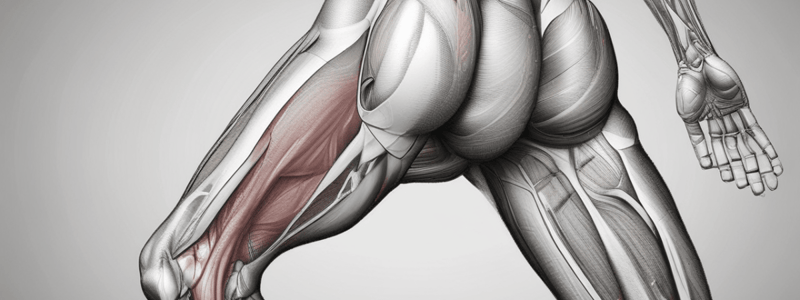Podcast
Questions and Answers
Which muscle primarily assists with hip flexion and has its origin on the lumbar vertebrae?
Which muscle primarily assists with hip flexion and has its origin on the lumbar vertebrae?
- Psoas Major (correct)
- Rectus Femoris
- Gracilis
- Adductor Longus
Which of the following muscles shares a mixed nerve supply from the obturator and femoral nerves?
Which of the following muscles shares a mixed nerve supply from the obturator and femoral nerves?
- Adductor Brevis
- Pectineus (correct)
- Iliacus
- Adductor Magnus
Which muscle originates from the anterior inferior iliac spine (AIIS)?
Which muscle originates from the anterior inferior iliac spine (AIIS)?
- Adductor Brevis
- Adductor Longus
- Gracilis
- Rectus Femoris (correct)
Which artery primarily supplies blood to the medial thigh muscles?
Which artery primarily supplies blood to the medial thigh muscles?
What is the primary function of the adductor muscles in the medial thigh?
What is the primary function of the adductor muscles in the medial thigh?
The iliacus has its origin at which anatomical location?
The iliacus has its origin at which anatomical location?
Which muscle's action includes assisting with trunk flexion?
Which muscle's action includes assisting with trunk flexion?
Which nerve supplies the majority of the medial thigh muscles?
Which nerve supplies the majority of the medial thigh muscles?
What function do the iliopsoas and medial thigh muscles share during walking?
What function do the iliopsoas and medial thigh muscles share during walking?
Which insertion point is common for the adductor muscles?
Which insertion point is common for the adductor muscles?
Flashcards are hidden until you start studying
Study Notes
Medial Thigh Muscle Anatomy
- Main Muscles:
- Adductor Longus
- Adductor Brevis
- Adductor Magnus
- Gracilis
- Pectineus
- Innervation:
- Obturator Nerve primarily (except pectineus: Femoral Nerve).
- Blood Supply:
- Profunda femoris artery (deep artery of the thigh).
- Function:
- Primarily responsible for hip adduction.
- Assist with hip flexion and medial rotation.
Anterior Hip Muscle Functions
- Key Muscles:
- Iliopsoas (composed of psoas major and iliacus)
- Rectus Femoris (part of quadriceps)
- Functions:
- Hip flexion: major action of iliopsoas.
- Assists with trunk flexion (psoas major).
- Rectus femoris also contributes to knee extension.
Muscle Origins And Insertions
- Iliopsoas:
- Origin: Psoas major (lumbar vertebrae), Iliacus (iliac fossa).
- Insertion: Lesser trochanter of the femur.
- Adductor Muscles:
- Origin: Pubis and ischium.
- Insertion: Linea aspera of the femur.
- Rectus Femoris:
- Origin: Anterior inferior iliac spine (AIIS).
- Insertion: Tibial tuberosity via patellar ligament.
Nerve Supply To Pelvic Muscles
- Iliopsoas: Lumbar plexus (L1-L3).
- Medial Thigh Muscles:
- Obturator nerve (L2-L4) for most.
- Pectineus: mixed supply (obturator and femoral).
- Rectus Femoris: Femoral nerve (L2-L4).
Muscle Actions And Biomechanics
- Hip Flexion:
- Primarily initiated by iliopsoas; assists with lifting the leg forward.
- Adduction:
- Medial thigh muscles converge to pull the thigh inward.
- Stabilization:
- Core and hip muscles work together to stabilize the pelvis during movement.
- Combined Movements:
- Many movements during walking include coordinated actions of flexors and adductors to maintain balance and efficiency.
Medial Thigh Muscle Anatomy
- Main Muscles include Adductor Longus, Adductor Brevis, Adductor Magnus, Gracilis, and Pectineus.
- Innervation primarily from the Obturator Nerve; Pectineus is innervated by the Femoral Nerve.
- Blood Supply is provided by the Profunda femoris artery (deep artery of the thigh).
- Function primarily involves hip adduction; also assists in hip flexion and medial rotation.
Anterior Hip Muscle Functions
- Key Muscles are Iliopsoas (comprised of psoas major and iliacus) and Rectus Femoris (a part of quadriceps).
- Functions include major hip flexion action from iliopsoas and assistance in trunk flexion from psoas major. Rectus Femoris contributes to knee extension.
Muscle Origins and Insertions
- Iliopsoas originates from lumbar vertebrae (psoas major) and iliac fossa (iliacus); it inserts at the lesser trochanter of the femur.
- Adductor Muscles originate from the pubis and ischium and insert at the linea aspera of the femur.
- Rectus Femoris originates at the anterior inferior iliac spine (AIIS) and inserts at the tibial tuberosity via the patellar ligament.
Nerve Supply to Pelvic Muscles
- Iliopsoas receives nerve supply from the lumbar plexus (L1-L3).
- Medial Thigh Muscles are generally innervated by the Obturator Nerve (L2-L4); Pectineus has a mixed nerve supply from both the obturator and femoral nerves.
- Rectus Femoris is innervated by the Femoral Nerve (L2-L4).
Muscle Actions and Biomechanics
- Hip Flexion is primarily initiated by the iliopsoas, facilitating leg lifting.
- Adduction involves medial thigh muscles converging to pull the thigh inward.
- Stabilization occurs as core and hip muscles work together to maintain pelvis stability during movement.
- Combined Movements during walking demonstrate coordination between flexors and adductors for balance and efficiency.
Studying That Suits You
Use AI to generate personalized quizzes and flashcards to suit your learning preferences.



